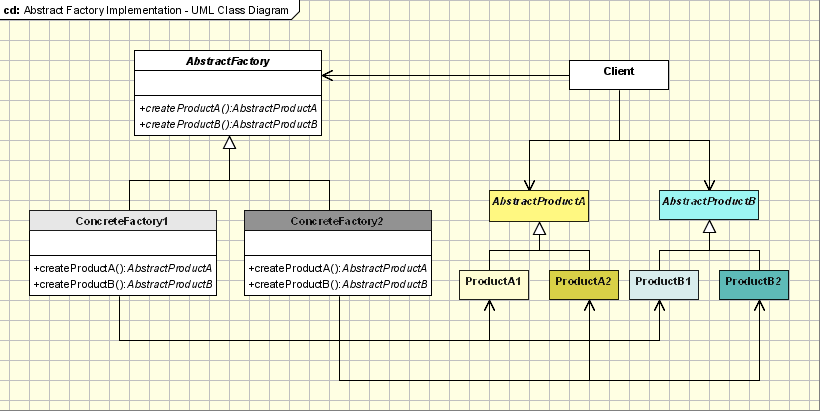抽象工厂模式二
来源:互联网 发布:直男癌语录 知乎 编辑:程序博客网 时间:2024/06/06 01:45
Motivation
Modularization is a big issue in today's programming. Programmers all over the world are trying to avoid the idea of adding code to existing classes in order to make them support encapsulating more general information. Take the case of a information manager which manages phone number. Phone numbers have a particular rule on which they get generated depending on areas and countries. If at some point the application should be changed in order to support adding numbers form a new country, the code of the application would have to be changed and it would become more and more complicated.
In order to prevent it, the Abstract Factory design pattern is used. Using this pattern a framework is defined, which produces objects that follow a general pattern and at runtime this factory is paired with any concrete factory to produce objects that follow the pattern of a certain country. In other words, the Abstract Factory is a super-factory which creates other factories (Factory of factories).
Intent
- Abstract Factory offers the interface for creating a family of related objects, without explicitly specifying their classes.
Implementation
The pattern basically works as shown below, in the UML diagram:
The classes that participate to the Abstract Factory pattern are:
- AbstractFactory - declares a interface for operations that create abstract products.
- ConcreteFactory - implements operations to create concrete products.
- AbstractProduct - declares an interface for a type of product objects.
- Product - defines a product to be created by the corresponding ConcreteFactory; it implements the AbstractProduct interface.
- Client - uses the interfaces declared by the AbstractFactory and AbstractProduct classes.
The AbstractFactory class is the one that determines the actual type of the concrete object and creates it, but it returns an abstract pointer to the concrete object just created. This determines the behavior of the client that asks the factory to create an object of a certain abstract type and to return the abstract pointer to it, keeping the client from knowing anything about the actual creation of the object.
The fact that the factory returns an abstract pointer to the created object means that the client doesn't have knowledge of the object's type. This implies that there is no need for including any class declarations relating to the concrete type, the client dealing at all times with the abstract type. The objects of the concrete type, created by the factory, are accessed by the client only through the abstract interface.
The second implication of this way of creating objects is that when the adding new concrete types is needed, all we have to do is modify the client code and make it use a different factory, which is far easier than instantiating a new type, which requires changing the code wherever a new object is created.
The classic implementation for the Abstract Factory pattern is the following:
abstract class AbstractProductA{public abstract void operationA1();public abstract void operationA2();}class ProductA1 extends AbstractProductA{ProductA1(String arg){System.out.println("Hello "+arg);} // Implement the code herepublic void operationA1() { };public void operationA2() { };}class ProductA2 extends AbstractProductA{ProductA2(String arg){System.out.println("Hello "+arg);} // Implement the code herepublic void operationA1() { };public void operationA2() { };}abstract class AbstractProductB{//public abstract void operationB1();//public abstract void operationB2();}class ProductB1 extends AbstractProductB{ProductB1(String arg){System.out.println("Hello "+arg);} // Implement the code here}class ProductB2 extends AbstractProductB{ProductB2(String arg){System.out.println("Hello "+arg);} // Implement the code here}abstract class AbstractFactory{abstract AbstractProductA createProductA();abstract AbstractProductB createProductB();}class ConcreteFactory1 extends AbstractFactory{AbstractProductA createProductA(){return new ProductA1("ProductA1");}AbstractProductB createProductB(){return new ProductB1("ProductB1");}}class ConcreteFactory2 extends AbstractFactory{AbstractProductA createProductA(){return new ProductA2("ProductA2");}AbstractProductB createProductB(){return new ProductB2("ProductB2");}}//Factory creator - an indirect way of instantiating the factoriesclass FactoryMaker{private static AbstractFactory pf=null;static AbstractFactory getFactory(String choice){if(choice.equals("a")){pf=new ConcreteFactory1();}else if(choice.equals("b")){pf=new ConcreteFactory2();} return pf;}}// Clientpublic class Client{public static void main(String args[]){AbstractFactory pf=FactoryMaker.getFactory("a");AbstractProductA product=pf.createProductA();//more function calls on product}}- 抽象工厂模式二
- 设计模式<二>-抽象工厂
- 二:创建型模式:抽象工厂模式
- 设计模式(二):抽象工厂模式
- JAVA--抽象工厂模式--设计模式二
- 设计模式笔记二:抽象工厂模式
- 设计模式(二) 抽象工厂模式
- 设计模式(二):抽象工厂模式
- JAVA设计模式(二)----抽象工厂模式
- 设计模式(二)抽象工厂模式
- 设计模式之 工厂模式(二) 抽象工厂模式
- 设计模式(二)工厂方法模式+抽象工厂模式
- iOS设计模式(二) 简单工厂,工厂,抽象工厂
- 工厂模式与抽象工厂模式小览(二)
- JAVA设计模式之二抽象工厂
- 工厂模式(简单工厂模式, 工厂方法模式, 抽象工厂模式)二
- [设计模式](二):工厂模式(简单工厂|静态工程、工厂方法|多工厂、抽象工厂)
- 工厂模式 -- 抽象工厂
- list练习实现
- PHP Charts 1.0 Remote Code Execution
- ubuntu linux下执行指定脚本不用输入密码
- C++中const限定符与指针
- Android中引入第三方Jar包的方法(java.lang.NoClassDefFoundError解决办法)
- 抽象工厂模式二
- Android中measure过程、WRAP_CONTENT详解以及xml布局文件解析流程浅析(下)
- 判断当前时间是否在限制时间段之内
- C#实现的ActiveX截图打印控件
- 教你如何迅速秒杀99%的海量数据处理面试题
- this 关键字的几种用法
- Plesk PHP Code Injection
- /AndroidRuntime(1185): android.os.NetworkOnMainThreadException 异常解决
- 查看SQL查询数据所话费时间


